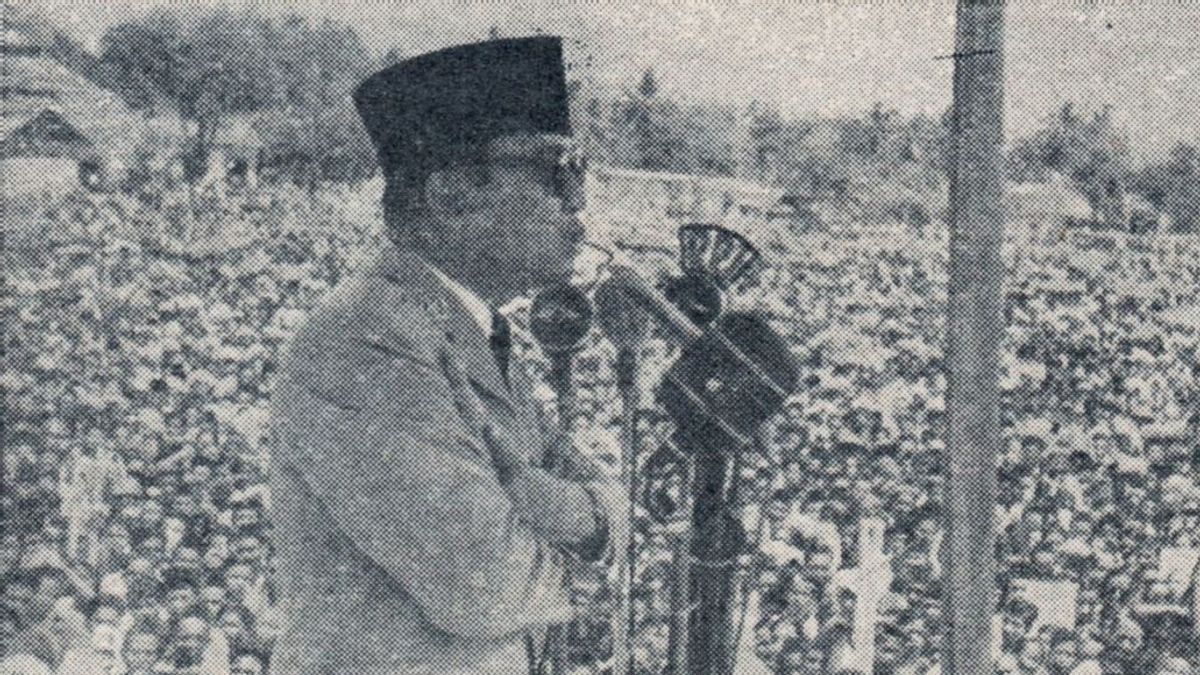JAKARTA - The issuance of the March Eleventh Order (Supersemar) in 1966 was a milestone in Indonesia's history. Before this letter was issued, on October 1, 1965, there were heinous killings that befell six high-ranking and one middle-ranking army officers. This event is not the only one. Other massacres lasted until December 1965.
Commander of the Army's Strategic Command, Major General Soeharto, is known to have succeeded in overcoming the September 30, 1965 Movement or commonly known as G30S/PKI. Soeharto's success in overcoming this tense situation made Major General Suharto in charge of being the Commander of the Operational Command for the Restoration of Security and Order (Pangkopkamtib).
Soeharto was then appointed as Commander of the Indonesian Army. On Friday 11 March 1966, President Soekarno chaired a session of the Perfected Dwikora Cabinet (Cabinet of 100 Ministers) at the Merdeka Palace, Jakarta.
However, President Soekarno left the trial early and was evacuated to the Bogor Palace by helicopter with Deputy Prime Minister I Soebandrio and Deputy Prime Minister III Chaerul Saleh. The inauguration session was then closed by Deputy Prime Minister II Dr. J. Leimena who then followed to Bogor.
It is known that the cause of Soekarno's evacuation was because news broke out that in addition to the student demonstrations, there was a group of unknown troops without attributes moving around Monas. The situation was then reported to Lieutenant Gen. Soeharto, who was not present at the hearing who admitted he was sick.
Soeharto took advantage of the Supersemar

Soeharto's absence resulted in the unidentified troop not being dispelled. To quote the Supersemar: Sejarah dalam Balutan Kekuasaan by Hendra Kurniawan, published at Bernas Jogja, the three generals, namely Basuki Rachmat, Amir Machmud, and M. Jusuf succeeded in being at the Presidential Palace.
They convinced Soekarno to issue an order to Lieutenant General Soeharto to secure the situation or this letter was known as the Supersemar. The letter was then signed, then received by Lt. Gen. Soeharto.
Since then, Indonesia's political path has changed. Instead of putting things in order, Suharto relied on the Supersemar for other things.

It did not take 24 hours after the signing of the letter, Suharto disbanded the PKI (Indonesian Communist Party) and arrested 15 ministers. Soeharto was also known to have removed Soekarno's supporters from the circle of power.
Soeharto slowly dismantled Soekarno's power. Until finally he succeeded in becoming the Second President of the Republic of Indonesia and ruled for 32 years.
Supersemar's impact on international politics
Quoted from a journal entitled Respons Jepang Dalam Gejolak Peristiwa 1965 (Japan's Response in the Turmoil of the 1965 Incidents) by Wildan Sena Utama, the birth of the Supersemar made the political map of Japan-Indonesia relations turn one hundred and eighty degrees.
According to a former diplomat at the Japanese embassy, embassy staff were happy with the Supersemar because they thought that Indonesia had escaped chaos and communist threats.
The Japanese government responded quickly to political change by providing assistance to the new government. The elimination of the PKI also had an impact on political change on a global scale in Asia.
The end of communist power in Indonesia had a significant impact on the United States (US), which was facing the Vietnam War in order to stem the spread of communist power in the Southeast Asian region.
The Supersemar is still a mystery

Until now, the Supersemar is still a mystery and controversy. This is because the original Supersemar has not been found.
The exact contents of the letter, whether to order Soeharto to maintain stability or the transfer of power is still a mystery. What is certain is that after the Supersemar, Indonesian politics really changed.
It is undeniable that after the Supersemar, Soekarno's leadership declined and Lieutenant General became increasingly popular. The government is more controlled by the military, which was previously civilian.
On March 12, 1967, Soeharto was sworn in as an interim President of the Republic of Indonesia. On March 26, 1968, Soeharto was officially inaugurated as the Second President of the Republic of Indonesia, officially replacing Soekarno.
The old order collapsed and was replaced by the new order. Two years later, on June 21, 1970, Soekarno died. The Indonesian proclaimer died under house arrest at the Bogor Palace, then was transferred to Wisma Yaso in Jakarta.
Others on TODAY'S HISTORY
SEE ALSO:
The English, Chinese, Japanese, Arabic, and French versions are automatically generated by the AI. So there may still be inaccuracies in translating, please always see Indonesian as our main language. (system supported by DigitalSiber.id)















